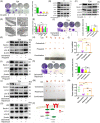Synergistic augmentation of osimertinib-induced autophagic death by proguanil or rapamycin in bladder cancer
- PMID: 37131539
- PMCID: PMC10148947
- DOI: 10.1002/mco2.236
Synergistic augmentation of osimertinib-induced autophagic death by proguanil or rapamycin in bladder cancer
Conflict of interest statement
The authors declare no conflicts of interest.
Figures

Similar articles
-
Inhibitory role of proguanil on the growth of bladder cancer via enhancing EGFR degradation and inhibiting its downstream signaling pathway to induce autophagy.Cell Death Dis. 2022 May 25;13(5):499. doi: 10.1038/s41419-022-04937-z. Cell Death Dis. 2022. PMID: 35614042 Free PMC article.
-
Vitamin K2 promotes PI3K/AKT/HIF-1α-mediated glycolysis that leads to AMPK-dependent autophagic cell death in bladder cancer cells.Sci Rep. 2020 May 7;10(1):7714. doi: 10.1038/s41598-020-64880-x. Sci Rep. 2020. PMID: 32382009 Free PMC article.
-
Regulation of paclitaxel-induced programmed cell death by autophagic induction: A model for cervical cancer.Obstet Gynecol Sci. 2013 Mar;56(2):84-92. doi: 10.5468/OGS.2013.56.2.84. Epub 2013 Mar 12. Obstet Gynecol Sci. 2013. PMID: 24327986 Free PMC article.
-
Atovaquone and proguanil hydrochloride: a review of nonclinical studies.J Travel Med. 1999 May;6 Suppl 1:S8-12. J Travel Med. 1999. PMID: 23573546 Review.
-
Malarone (atovaquone and proguanil hydrochloride): a review of its clinical development for treatment of malaria. Malarone Clinical Trials Study Group.Am J Trop Med Hyg. 1999 Apr;60(4):533-41. doi: 10.4269/ajtmh.1999.60.533. Am J Trop Med Hyg. 1999. PMID: 10348225 Review.
Cited by
-
Inhibition of Cyclin D1 by Novel Biguanide Derivative YB-004 Increases the Sensitivity of Bladder Cancer to Olaparib via Causing G0 / G1 Arrest.Int J Biol Sci. 2025 Feb 18;21(5):1984-1998. doi: 10.7150/ijbs.105072. eCollection 2025. Int J Biol Sci. 2025. PMID: 40083696 Free PMC article.
-
Metformin-Loaded Chitosan Hydrogels Suppress Bladder Tumor Growth in an Orthotopic Mouse Model via Intravesical Administration.Molecules. 2023 Sep 20;28(18):6720. doi: 10.3390/molecules28186720. Molecules. 2023. PMID: 37764495 Free PMC article.
-
Prolonged Response to Osimertinib in EGFR-Mutated Metastatic Urothelial Carcinoma, a Case Report.Curr Oncol. 2024 Jul 14;31(7):4015-4021. doi: 10.3390/curroncol31070298. Curr Oncol. 2024. PMID: 39057170 Free PMC article.
References
-
- Siegel RL, Miller KD, Fuchs HE, Jemal A. Cancer statistics, 2022. CA Cancer J Clin. 2022;72(1):7‐33. - PubMed
-
- Dai CH, Shu Y, Chen P, et al. YM155 sensitizes non‐small cell lung cancer cells to EGFR‐tyrosine kinase inhibitors through the mechanism of autophagy induction. Biochim Biophys Acta Mol Basis Dis. 2018;1864(12):3786‐3798. - PubMed
LinkOut - more resources
Full Text Sources
